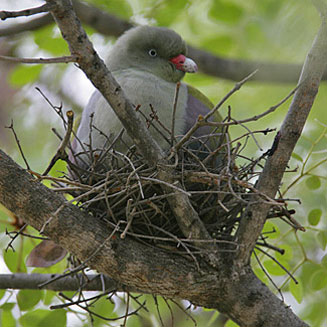|
Treron calvus (African
green-pigeon, Green pigeon)
[= Treron calva]
Papegaaiduif [Afrikaans]; Intendekwane [Xhosa]; iJubantondo
[Zulu]; Mpungu huriti [Kwangali]; Huriti [Shona]; Litubantfontfo [Swazi];
Nghwamba [Tsonga]; Leebamoru [Tswana]; Afrikaanse papegaaiduif [Dutch]; Colombar
ŕ front nu [French]; Grüne fruchttaube, Grüntaube [German]; Pombo-verde-africano
[Portuguese]
Life
> Eukaryotes >
Opisthokonta
> Metazoa (animals) >
Bilateria >
Deuterostomia > Chordata >
Craniata > Vertebrata (vertebrates) > Gnathostomata (jawed
vertebrates) > Teleostomi (teleost fish) > Osteichthyes (bony fish) > Class:
Sarcopterygii (lobe-finned
fish) > Stegocephalia (terrestrial
vertebrates) > Tetrapoda
(four-legged vertebrates) > Reptiliomorpha > Amniota >
Reptilia (reptiles) >
Romeriida > Diapsida > Archosauromorpha > Archosauria >
Dinosauria
(dinosaurs) > Saurischia > Theropoda (bipedal predatory dinosaurs) >
Coelurosauria > Maniraptora > Aves
(birds) > Order: Columbiformes > Family:
Columbidae > Genus: Treron
The African green-pigeon is found from Senegal to east
Africa, extending south to southern Africa, where it is fairly common in a wide
variety of habitats. It mainly eats fruit, as well as very small quantities of
seeds, flesh and even dry blood! The female builds the nest, using material
gathered by the male. The nest is a flat platform of twigs and leaves, placed in
the fork of a tree. It lays 1-2 eggs, which are incubated by both sexes, for
13-14 days, with the chicks staying in the nest for 11-13 days.
Distribution and habitat
Occurs across sub-Saharan Africa, extending south to
southern Africa, where it is fairly common in northern Namibia, northern and
eastern Botswana, Zimbabwe, Mozambique, Swaziland and eastern South Africa. It
occupies a variety of habitats, including closed evergreen
forest, high rainfall miombo (Brachystegia) woodland, mixed woodland,
coastal dune forest, parks and gardens.
|
 |
|
Distribution of African green-pigeon in southern Africa,
based on statistical smoothing of the records from first SA Bird Atlas
Project (©
Animal Demography unit, University of
Cape Town; smoothing by Birgit Erni and Francesca Little). Colours range
from dark blue (most common) through to yellow (least common).
See here for the latest distribution
from the SABAP2. |
Predators and parasites
Food
It mainly eats fruit, as well as very
small quantities of seeds, flesh and even dry blood! It forages like a
parrot, clambering around on slender branches in
the canopies of trees, rarely coming coming down to the ground. The following
food items have been recorded in its diet:
- Plants
- fruit
- Ficus (wild figs)
- Ficus bussei (Zambezi fig)
- Ficus sur (Broom-cluster fig)
- Ficus elastica (alien Rubber tree)
- Mystroxylon aethiopicum (Kooboo-berry)
- Elaeodendron transvaalensis (Bushveld saffron)
- Diospyros mespiliformis (Jackal-berry)
- Halleria lucida (Tree-fuchsia)
- Manilkara discolor (Forest milkberry)
- Mimusops zeyheri (Red milkwood)
- Morella (western waxberries)
- Pappae capensis (Jacket-plum)
- Podocarpus (yellowwoods)
- Syzygium cordatum (Waterberry)
- Melia azedarach (alien Persian lilac)
- Durantia repens (Forget-me-not bush)
- Morus (mulberries)
- cultivated fruit
- dry seeds
- Carrion
- small pieces of flesh
- dried blood of Tragelaphus angasi (Nyala)
carcasses (recorded once in Zimbabwe).
- Wet and dried mud at water hole.
Breeding
- The female builds the nest using material gathered
by the male, consisting of a flat platform of twigs and leaves, typically placed in
the
fork of a tree. Of 63 nests located, 3 were in riverine woodland, 12 were in
suburban gardens and 48 were in woodlands, such as miombo (Brachystegia),
Acacia and Mopane
(Colospermum mopane).
 |
|
|
African green pigeon at its nest, Modimolle, South
Africa. [photo Warwick Tarboton ©] |
|
- Egg-laying season is mainly August-January.
- It lays 1-2 eggs, which are incubated by both sexes for about 13-14 days.
- The chicks stay in the nest for 11-13 days.
Threats
Not threatened, in fact quite common across southern
Africa. It has adapted very well to living with humans, as it often nests and
roosts in buildings.
References
-
Hockey PAR, Dean WRJ and Ryan PG 2005. Roberts
- Birds of southern Africa, VIIth ed. The Trustees of the John Voelcker
Bird Book Fund, Cape Town.
|
